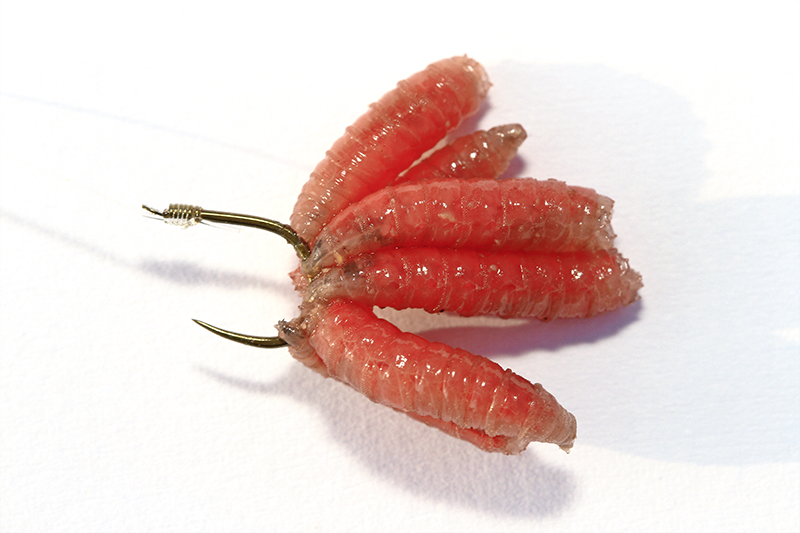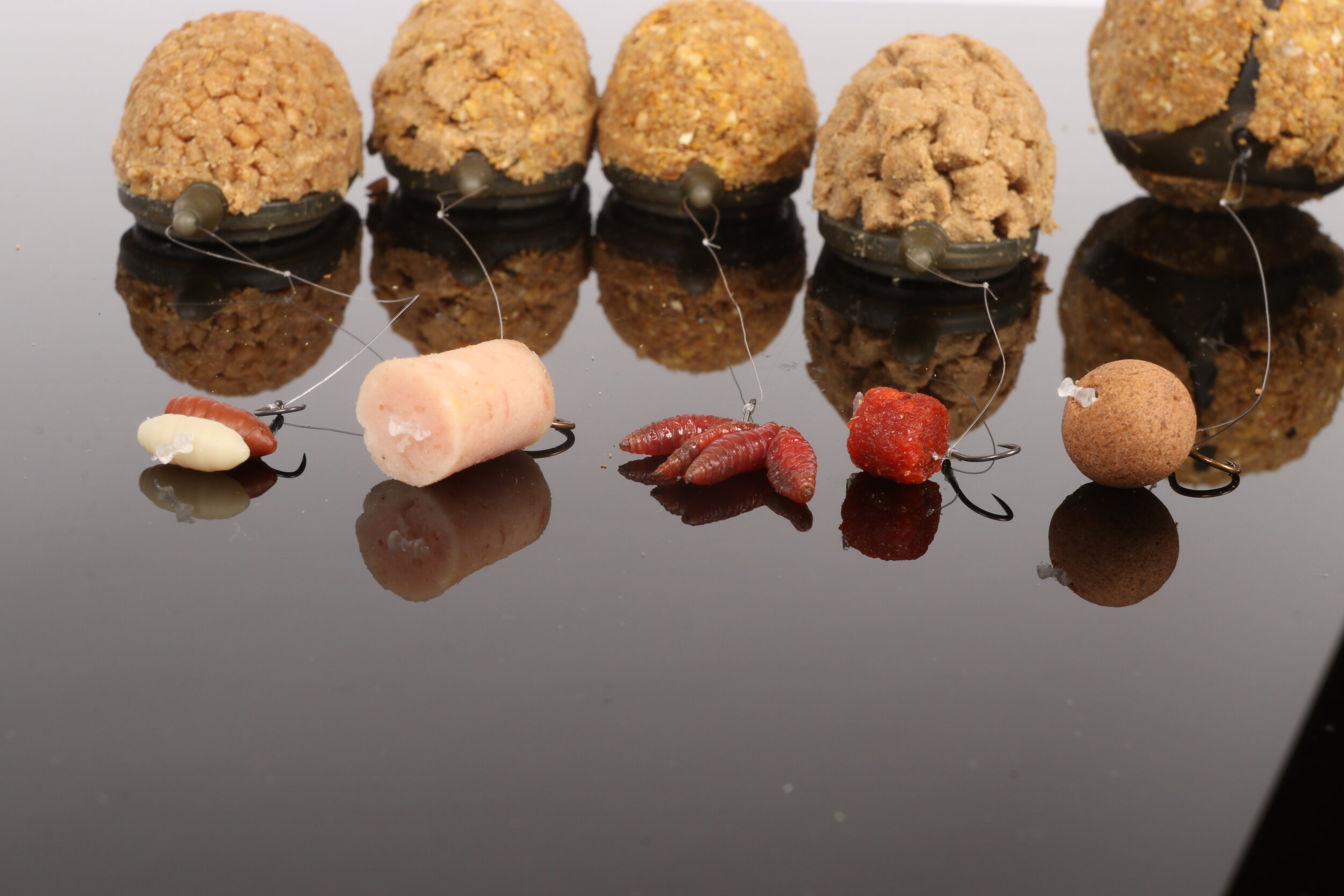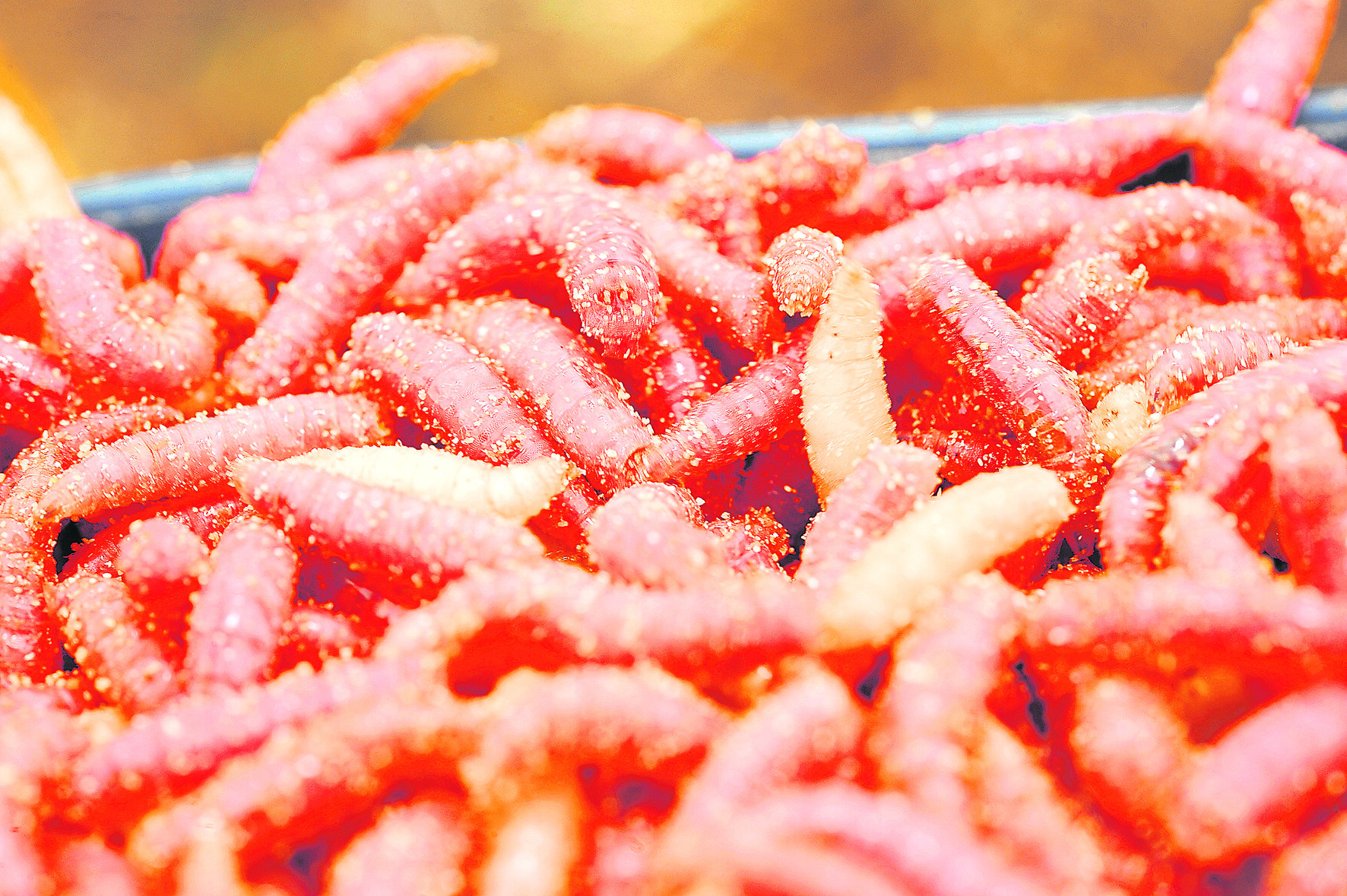Steve Ringer's top 10 baits to use when fishing commercials.
Are you looking for for an edge when it comes to being on a commercial fishery? Then follow match ace Steve Ringer's top 10 baits that he uses when fishing for carp on a commercial as these tips will give you the advantage that you need.
1) Margins – big baits means more bites
When fishing in the edge, one of the hardest things is getting a carp to pick up your hookbait, especially when a lot of them are feeding. I would go as far as to say there is nothing more frustrating than being able to see carp in the edge and then not be able to catch them. This is where a big ‘target bait’ such as 10-12 dead red maggots really comes into its own.
If you think about it there are going to be lots of maggots on the bottom so if I fish just two or three on the hook it’s going to take a while for a carp to find them. Fish a bunch, however, and bites can be instant! That’s how much of a difference it can make.
2) Blow up your pellets
A few years back I was doing a lot of straight lead and pellet fishing but always felt I was missing an edge over other anglers who were fishing the same tactic. Then one day when I was packing up I noticed a few pellets had fallen under my seatbox. What struck me was the size of the pellets – they had taken on water and were almost twice the size.
This got me thinking as the same thing had to be happening in the water once the pellets had been on the bottom a while. I therefore decided to pump some hard 8mm pellets and leave them in water so that they ‘blew up’ into massive, soft pellets.
Once I got the process of prepping the pellets rightthe results were staggering and I was getting more bites than ever before on my ‘new’ blown pellets! I had found the edge I had been looking for and ever since that day when lead and pellet fishing I always have a few ‘blown’ pellets with me.
3) Hard pellets - noise is the key
When the fishing is hard and there isn’t a lot happening I am big believer in trying to draw a few fish into the swim and the best way to do so is to make a noise with hard pellets. I pick up my catapult and ping just 3-4 pellets on top of the float every 20 seconds.
The reason this works is that carp home in on the noise of the pellets hitting the water but at the same time I’m not putting lots of bait on the bottom and risking killing the swim. Size-wise this tactic works best with either 6mm or 8mm pellets because anything smaller doesn’t make enough noise to help pull a fish or two into the swim.
4) Coloured water equals red meat
I love fishing meat but it loses its effectiveness when the water is extremely coloured. When this is the case I will take a handful of my 6mm cubes and dye them red. The reason being when the water is very coloured red offers a strong silhouette and gives the carp a bait they can really home in on.
I was always sceptical about red meat in the past but I’ve had good results using it too many times in coloured water conditions for it to be coincidence. I use Ringers Red Liquid to dye my cubes and will only dye my hookbait meat and not the cubes used for feeding.
5) Foul-hooking? Hemp is the answer
I’m often asked how to prevent foul-hooking carp when fishing meat close in?
My answer is to use hemp. But, and it’s a big but, it has to be used in the right way. If you feed it little and often along with the meat then there is a danger the carp can get preoccupied on it and you won’t be able to catch them.
It’s much better to use hemp purely as settling bait. So at the start I will pot in two thirds of a large 250ml Drennan pot of just hemp to form a bed. Then if I start to catch a few and then start to suffer from foul hooking, I will simply introduce another big pot of hemp to settle them back down again.
6) Feed heavy close in to get out of jail
Every now and again in a match you need a get- out-of-jail card and, while most people use the margins for this, I prefer to fish short on a top kit straight in front of me. I mix hemp, corn and meat and simply lash it in to create the impression of someone packing up and throwing all their bait in.
I normally kick the swim off with three big handfuls of bait and go straight in over the top because quite often I will get a quick response from a fish within seconds. From that point on I will keep lashing the bait.It’s an approach that doesn’t always work but it has paid off on many occasions for it to be my ‘go to’ line when things aren’t going to plan.
7) Pack in the particles for bream
The secret to building a big weight of bream is particles particles – casters, pellets, worms etc. I pile in the particles in the first hour to put a bed of bait on the bottom. To do thisuse a bigger feeder and cast more often. Then when the bream turn up, perhaps 90 minutes in, I have a lot more bait on the bottom to hold the bream for longer.
8) Corn – two grains are better than one
Sweetcorn is a fantastic bait all year round but it’s particularly effective at this time of year. The interesting part about corn is that when it comes to fishing it on the hook then I always tend to find that two grains are without doubt better than one.
Loads of times I have caught on corn and alternated between single and double on the hook only to find two grains constantly produced quicker bites and bigger fish. There are two possible reasons for this, firstly the bigger bait stands out more over the loose offerings so the carp spot it that bit quicker, or it could be that everyone tends to fish a single grain of corn so two grains gets treated with less suspicion.
9) Stand out or blend in?
When fishing the Method or Hybrid feeder there are loads of different hookbaits you can use but I like to simplify things by dividing them into two camps, blend-in and stand-out. Blend-in baits are those such as hard pellets that match the pellets on the feeder. When the fishing is hard this type of bait takes some beating.
The reason for this is that when the fishing is hard there aren’t many fish in the swim so those that are there can afford to be picky about what they pick up. Hence a blend-in bait works well as it can trick even the wariest of carp.
If, however, there are loads of fish in the swim then stand-out baits such as mini fluoro boilies or bread really come into their own. These work because they are highly visible and give the carp something they can really home in on.
10) Give your meat a double cut
A couple of years back I spent a lot of time at Tunnel Barn Farm fishing meat into the shallow water across to far banks and islands. The problem was I struggled to hold the fish in the swim for long periods when feeding 6mm cubes.
What I needed, of course, was to create a cloud to firstly draw the fish in and then hold them in the swim once they arrived. To achieve this I decided to create a meaty mush by passing around a third of my 6mm meat cubes back through the cutter again, giving myself a feed made up of different sizes which almost exploded on the surface of the water.
This was added to 8-10 6mm cubes in my pot so when it was fed the cloudy mush pulled the fish into the swim and once they arrived they followed the 6mm cubes down to the bottom so I could catch them!
Best coarse fishing hookbaits to be using right now!
Tommy Pickering gives his opinion on the best hookbaits that you should be using right now if you are wanting to catch consistently.
The rise in temperatures in recent weeks has stirred fish stocks into feeding, but careful consideration still needs to be given to your bait choices if you are to succeed. Pick the wrong hookbait and there’s every chance that your target species will ignore it and leave you struggling for action. If I had to pick five baits to see me through the next few weeks, these are what they would be...
Casters.
These pick out the biggest silverfish in the shoal – the orangey-brown ones are best. Double and single caster works on a size 16 or 18 hook when roach and skimmers are the target fish.
Pellets.
Fish consider these their main food source. Hard pellets in a bait band score on bomb, waggler or pole for quality carp and F1s. Soft expanders are a better option for bonus tench and skimmers.
Meat.
In winter this can be fantastic on the bomb for commercial carp and F1s or river barbel. I push a tin through a meat cutter to create 6mm or 8mm cubes. Avoid cheap, fatty brands that tend to float.
Maggots.
Maggots tend to attract small fish to start with but bigger bonus fish may then move in. Dead maggots are extremely effective when used as a hookbait on the Method feeder.
Sweetcorn.
In clear water, a grain of corn stands out a mile. Use it on the bomb on a size 16 or 18 hook when casting around to find a shoal, or loosefeed it sparingly on the pole line through a small cup.
Steve Ringer's favourite corn hookbaits for carp!
I use both corn and wafters for hookbaits, and will change my hook based upon which bait I’m using. When fishing corn on the hair I’ll use a size 18 Super MWG.
If I change hookbaits from corn to a yellow wafter I will switch to a size 14 QM1 hook and a 0.17mm hooklength – still 75cm long, of course.
In terms of hookbait choice, contrary to popular belief corn gives you quite a few! To simplify things, though, there are three I like to concentrate on...
1) Corn stack
This involves hair-rigging multiple grains through the narrowest part. The advantage of fishing a stack is that you are creating a big, stand-out bait and offering the carp something a little different to what they are used to.
2) Dumbell wafter
A 10mm yellow dumbell wafter resembles a grain of corn and blends in well with the loose offerings. It has two key benefits over the corn – being so light it sinks very slowly through the water, increasing the chances of a carp seeing it and following it down. Then, once on the bottom, it becomes a very light hookbait that is easily sucked up by a feeding fish.
3) Corn string
This is a real favourite of mine. The ‘string’ is a number of grains hair-rigged through the long part of the grain, and gives the fish an easy bait to spot. It gives the appearance of multiple grains lying next to each other on the bottom, and fish can pick up a lot of feed in one easy go.
Fishing with liquidised sweetcorn
If you are looking for an edge when fishing a commercial carp water during spring, summer, autumn or winter, you will do well by fishing a grain of corn directly over the top of a cloud of liquidised sweetcorn.
Mushed up grains of sweetcorn are absolutely deadly on some commercial waters due to two reasons. Firstly the crushed up kernels produce a yellow, milk-like cloud in the water that disperses flavour throughout the depths pulling fish in from all angles.
Secondly this technique provides masses of attractants but very little food - the only food that the carp will find are small taorn kernels of corn so your whole corn hookbait will stand out like a sore thumb, providing an ideal target for the fish to home in on.
During the winter, when the water temperature is at its lowest, the water is also at its densest. This increase in density means that the cloud spreading out from liquidised corn will linger in the water for longer, attracting fish from far and wide.
Once the fish are attracted to the area, there is little for them to eat except the hookbait. This will mean you get more bites.
Here’s how you make and use it:
1. Tip the tin of corn, juices and all, into a food processor or blender...
2. Do not obliterate the kernels when preparing liquidised corn - give the tinful of corn a five to 10 second blitz then check it and repeat if needed.
3. The finished corn mush should retain a few bits of kernel for the fish to pick over. This helps to hold the fish in the area once the sweet cloud of feed has attracted them.
4. To feed the liquidised corn you must use a pole cup. Dribble a pinch of corn mush into the cup, carefully ship out to the exact spot you’re fishing and drop it into the water. Look at the cloud that spreads out.
TOP TIP
When liquidising sweetcorn, it is possible to add flavours or colours to the mixture to give it a different signature if you wish.
Sweetcorn – one of the best coarse and carp fishing baits
If there’s one bait that will catch good quality coarse fish month in month out it is sweetcorn. It’s one of fishing’s most useful baits due to its bright colour and sweet scent. It is a versatile bait in that it can be flavoured, coloured, fished on the hook, fished on a hair rig, and even mushed up to make a great groundbait.
Another plus point in sweetcorn’s favour is its availability – you can buy a tin from supermarkets, corner shops and even some petrol stations, so you’re never far away from a supply of great tench, bream, roach, carp and barbel bait.
Hooking sweetcorn
Always follow the old adage – use the right size of hook to suit the bait you are using. For a great little guide to hook sizes click here.
Placing sweetcorn directly onto the hook is quite easy – simply take a grain by the flattened side and pierce the rounded section of the grain with the hook point. Gently pass the hook point inside the grain and twist as you go to work the hook point out of the flat part and out of the grain.
If you wish to hair rig your sweetcorn you can do it one of two ways, upright or flat. To hair rig sweetcorn upright pass your baiting needle straight through the flat side of the kernel and thread the bait onto your hair. This isn’t the best way to hair rig it as the bait may well sit upright on the bottom, and that’s quite unnatural.
To hair rig sweetcorn so that it lays flat on the bottom pass the baiting needle through the widest part of the kernel and pull the hair through the bait that way. Now, when the bait lands on the bottom, it will lie flat and therefore look completely natural to a passing fish.
Flavouring and colouring sweetcorn
Many anglers prefer to simply use sweetcorn straight from the tin as it has enough colour and flavour to attract the fish they seek, but on some venues where sweetcorn has been used to excess the angler may need to alter the bait slightly to make it more attractive, and to trick the fish into taking it.
To flavour and colour the bait open the can and tip out the juice. Now tip the grains into a plastic bag and add a squirt of your chosen flavour and a few drops if colouring. Supercook food dye – available from all good supermarkets is as good as any here – and blow into the bag to fill it with air. Now twist the neck of the bag and give the bait a good shake to disperse all the ingredients.
Now squeeze all the air out the bag, seal it and freeze it overnight. When you take it out and allow it to thaw the flavour and colour will be drawn right into the bait making it even more effective than if you used it immediately.
Pre-baiting with corn
Anyone thinking of pre-baiting a swim for tench, carp or bream should think about adding sweetcorn to their groundbait or particle mix. A bag of frozen corn is far cheaper than buying tins of the stuff and will help bulk the pre-baiting mix out, adding colour and scent that is sure to attract the fish into your area, for them to feed on all the other goodies you have in the mix.
Sweetcorn as groundbait
Have you got a liquidiser? If so you will be able to make a great groundbait or groundbait additive that works brilliantly for roach, carp, bream, tench and rudd.
Pour the whole contents of a tin of corn into your liquidiser and give it a blast until the grains turn to a mush. This mush can be added to dampen a Method mix groundbait to give it extra scent and a scattering of colour, or it can be scooped into a pole cup and fed into your Stillwater swim to create a scented cloud that fish can’t refuse a quick sniff at.
You might need to scoop the pole cup under the water as you tip the contents out to help remove the sticky sludge from your cup though.
A few pellets added to the liquidised corn will give the fish something to get stuck into when they come to the yellow cloud.
Imitation sweetcorn
If you want to use sweetcorn for big fish, but there are masses of roach and rudd in your venue, you might like to consider using plastic, fake corn instead as the small fish can’t smash this bait to pieces.
There are two types of imitation sweetcorn – those that sink and those that float. Be sure to buy the type you want to use.
Simply follow the hooking tips above to hair rig your imitation sweetcorn and present it over a few grains of natural corn. Don’t be put off with the bait being plastic – once the fish arrive in your swim and start munching away they won’t know the difference – you’ll soon get a run off a specimen fish.



































